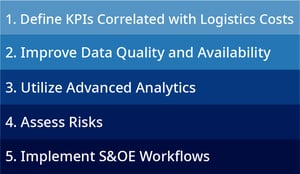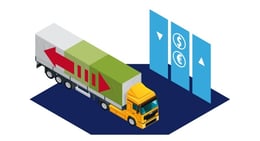A 5 Step Guide to Optimizing Total Logistics Costs
Brian Hoey - December 06, 2018

 Buying health insurance in the U.S. is an odd business. Essentially, you have to balance your monthly premium (i.e. the amount that you pay your insurance provider each month for continued coverage) with your deductible (the amount that you have to pay out of your own funds before the insurance company will contribute to your care, broadly speaking). In general, if one of those two costs is particularly high, the other is likely to be lower, and vice versa. If you’re thinking about your choice in terms of total cost, a high deductible is risky, but has the potential to be cheaper if you can avoid getting sick over the course of the year. A high premium, on the other hand, might put you in a position where you’re essentially paying for medical care that you’re not receiving. The question, then, is how much risk are you willing to take on?
Buying health insurance in the U.S. is an odd business. Essentially, you have to balance your monthly premium (i.e. the amount that you pay your insurance provider each month for continued coverage) with your deductible (the amount that you have to pay out of your own funds before the insurance company will contribute to your care, broadly speaking). In general, if one of those two costs is particularly high, the other is likely to be lower, and vice versa. If you’re thinking about your choice in terms of total cost, a high deductible is risky, but has the potential to be cheaper if you can avoid getting sick over the course of the year. A high premium, on the other hand, might put you in a position where you’re essentially paying for medical care that you’re not receiving. The question, then, is how much risk are you willing to take on?
For manufacturers in the modern, global supply chain, it’s not uncommon to face a similar question: You want to lower your total logistics costs, but how much risk are you willing to incur in order to do so? If you try to reduce costs by going lean and reducing your buffer stock (to save on storage and warehousing costs), you face the possibility of costly stock shortages if there’s an unexpected spike in demand. The goal, by and large, is to reduce costs while incurring as little additional risk as possible. Here’s a five step guide to doing just that.
1. Define KPIs Correlated with Logistics Costs
For the sake of argument, let’s say that you already know what your total logistics costs come to on a monthly or annual basis. But do you know what the biggest contributors to those costs are? For many businesses, the bulk of your expenses will be things like fuel and warehouse storage, but for others the most significant factors might be late deliveries or tariffs and fees. Before you can start in on optimizing your total logistics costs, you need to determine the KPIs that best correlate with those costs, so that you can begin to determine the most efficient way to optimize them. If, for example, you find that your logistics spending goes up when your forecast accuracy is poor, you’ll want to identify this connection right away so that you can spend your time and resources improving those forecasts.
2. Improve Data Quality and Availability
You may have looked at the step above and thought to yourself, “easier said than done!” We’re right there with you. That’s why this second step (which you might have to interchange with the first in order to get a more granular view of your operational expenses) is aimed at providing you the visibility that you’ll need to assess, analyze, and ultimately optimize your existing workflows. To begin with, do a simple check: choose a piece of information and see how easy or difficult it is to find. If it’s relatively straightforward, then you’re probably operating at a high enough level of visibility that you can get a handle on the cross-operational impacts of each business function on your logistics costs. If not, you may have to make a point of rooting out data silos and creating a connected IT framework that makes mission critical information accessible across the value stream. In this way, you create the visibility required for smarter operational change, as well as the data availability required for the next step:
3. Utilize Advanced Analytics
Now it’s time to move past the preliminaries and into the cost savings. If you’ve identified the areas that impact your total logistics cost most significantly and created an IT environment that privileges data accessibility, it’s time to turn that data into usable insights. By training advanced prescriptive and predictive algorithms on your existing logistics operations, you can create a simulated digital twin of your factory or your supply chain. You can then use analytics processes aimed at the areas you have determined to be the most critical for optimizing your logistics costs, and use prescriptive analytics to uncover any existing areas of waste or inefficiency. By the same token, you can use predictive analytics to run simulated scenarios of different hypotheticals that might arise in your supply chain. Not only will this help you to automate the process of finding, for example, the most efficient use of space in your warehouse, it can also help you model future changes to your supply chain logistics paradigms in order to let you visualize the effects of future changes.
4. Assess Risks
Finally, we’ve made it back around to the question of acceptable risk. Once you’ve got your digital twin in place, the question of assessing the risks of any given decision becomes much more straightforward. If you’re finding that keeping a large amount of reserve stock is contributing to a high overall logistics cost, analytics processes will give you the power to run What-If scenarios on potentially leaner inventory management plans in order to see what the likely outcomes are. Thus, you can weight the risks against the potential cost savings, and let those considerations guide you as you make changes within your supply stream.
5. Implement S&OE Workflows
No two businesses are the same, and one of the takeaways from this list so far should be that no two businesses will take an identical path to logistics optimization. While the first four steps that we’ve laid out have largely required different businesses to determine their own priorities for optimizing total logistics costs, this last one, we believe, actually applies in virtually all cases. Whatever challenges you’ve identified within your own value stream, sales & operations execution (S&OE) can help you meet them in a way that reduces costs by minimizing disruption. How? By turning real-time transport information and demand data into small daily and weekly adjustments to inventory levels and transport routing. In this way, businesses are able to bridge the gap between longer term planning cycles and day to day fluctuations from the expected. By and large, this function helps businesses to avoid overreacting to short-term deviations from the norm, but over the course of a quarterly or yearly planning cycle, these small adjustments add up to a considerable impact, keeping plans on track and giving the entire company an up-to-the-minute snapshot of demand. If you’re still interested in ways to keep your logistics costs down, you can learn more about S&OE here.
LATEST POSTS
- Understand Why Production Planning Needs Specialized Solutions
- Understand Circular Economy in The Manufacturing Industry
- How Can Industry 4.0 IT Integration Be Achieved Smoothly?
- The Significance of Order Sequencing in Discrete Manufacturing
- How to improve your Supply Chain Management: The Power of Control Towers



